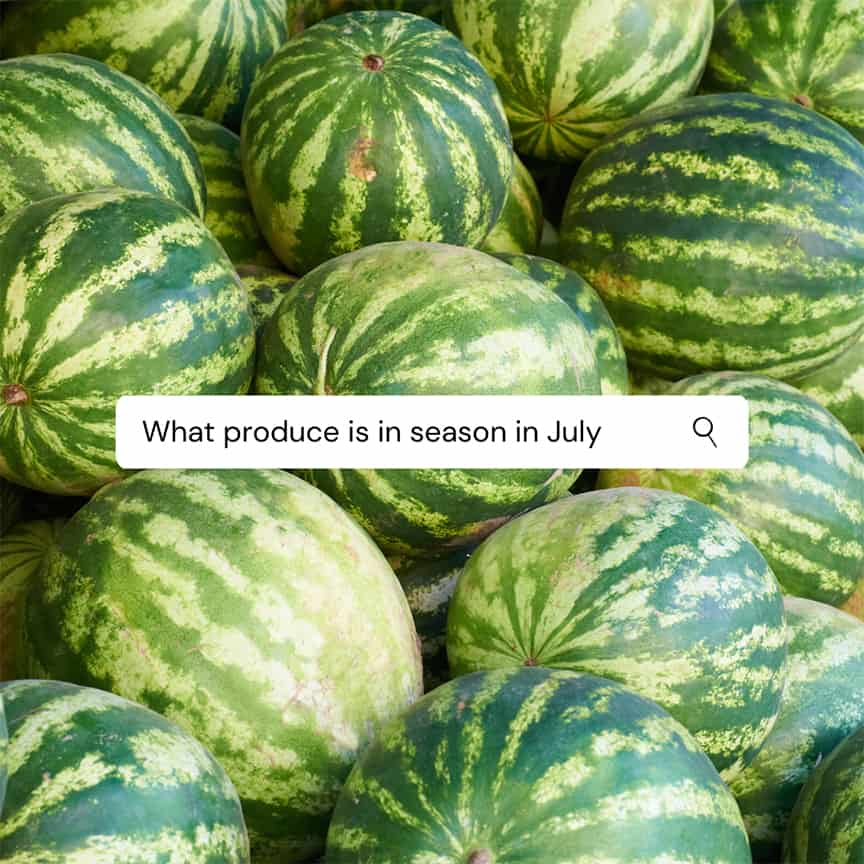What’s in Season in July
If you’re anything like me, the onset of summer means shaking your fist at slugs and savouring the first ripe berries of the season. July is a magical month when the rains of ‘Juneuary’ subside and backyards become bountiful. If you love fresh, local food, but gardening isn’t your thing (or you don’t have the space or time), you’ll want to know which fruits and veggies are in season in July and where to go to find your local farmers market.

Fruits and veggies in season in July
In British Columbia, stone fruits such as peaches, plums, apricots, and some nectarines start to pop up at markets and farm stands as early as July (in the Atlantic provinces, you’ll probably have to wait until September). Berries are also on the menu this month, with salmonberries, blackberries, raspberries, and strawberries coming into season along with some early cherries. Now’s also the time to look for gooseberries, currants, and Saskatoon berries if you like things a little tarter.
In the vegetable garden, July is a great month for some varieties of green beans and peas, as well as broccoli, carrots, cauliflower, celery, Swiss chard, fresh garlic, leeks, lettuce, green onions, some early cucumber varieties, spinach, salad greens, zucchini, and kale. Some other fruits and veggies to watch out for this month include turnips and beets, as well as watermelon in some hotter areas.
Depending on how much sun you saw in June, you might be lucky enough for some peppers, peaches, and tomatoes, and now’s also the time to check for fresh rhubarb and delicate new potatoes.
And finally, if you’ve been working from home and homeschooling, chances are you’ve sowed some quick-sprouting seeds in an effort to keep your kids entertained and active. Now’s the time you’ll start seeing the fruits of that labour as radishes will soon be ready for harvest!
Why eat local and seasonal?
Buying fresh produce from your local farmers market is a great way to eat local, in-season food and support your community. Sure, you could take a trip to the store and buy greenhouse strawberries from thousands of miles away in the middle of December, but nothing beats a strawberry picked fresh from a local farm that morning.
Not only does fresh produce pack a lot more flavour (and nutrients!), eating local, in-season produce also helps cut your carbon footprint. Most fruits and vegetables for sale in the grocery store have spent weeks in transit, whether by boat, air, train, or truck. The produce is often picked before it is at its peak, acknowledging the time it takes to ship to stores. In contrast, your local farmers’ market is packed with produce picked that morning and most of that produce is happily free of plastic packaging, further reducing the environmental impact of your food choices.
Farmers’ markets are also a great opportunity to engage with farmers about their growing practices and seasonal successes. This might help you find a fantastic local grower that keenly follows organic and/or biodynamic processes, but hasn’t had the cash or time to seek certification.
Taking a stroll through your local farmers market, or visiting a farm stand with the family also makes it easier to get kids excited about novel fruits and veggies. This can help increase the proportion of plant-based foods in your diet. Buying local could help you reduce your greenhouse gas emissions by 4–5%, but increasing plant-based foods and reducing meat and dairy intake is, by far, the most effective way to reduce your environmental impact.
If you do buy animal products such as meat and milk, though, buying from a local farmer who has a pasture-fed herd means you’re not actively contributing to deforestation in the Amazon. Research indicates that cattle-ranching accounts for some 80% of current deforestation in the region.
Eating local also helps sustain a more robust, resilient local food economy, the importance of which has been squarely brought home during this global pandemic. Supporting your nearest small-scale farmers helps keep money in the local economy. And, because those farmers live and work where you do, it’s far more likely they want to adopt and maintain sustainable agricultural practices that reduce the risk of environmental degradation. This can mean cleaner waterways, less air pollution and a generally happier and healthier environment.
One final benefit of eating local, in-season produce is that it can save you money! Buying fresh in-season produce means you buy when supply is at its peak, so farmers can pass along savings directly to you. In some provinces and territories, such as BC, farmers markets even have nutrition coupon programs where lower-income families, folks who are pregnant, and seniors can access vouchers to buy local, fresh food directly from farmers.
Where to find your local farmers’ market?
The best way to find a farmers’ market near you is to ask around! If you have foodie friends, chances are they can point you in the right direction. Or, if you’re new to an area, check with the local tourism board or regional district or city office.
Many provinces also maintain a directory of local farmers’ markets, which can be found here:
Alberta
BC
Manitoba
New Brunswick
Nova Scotia
Ontario
Quebec
Saskatchewan
You can also find details of community markets in the Yukon.
Eating seasonally is a great way to reduce your carbon footprint and all while enjoying fresh fruits and veggies when they’re at their best. July is an abundant month, but don’t worry if you’re late to the party, August is even better! With grapes and artichokes to look forward to, it’s even easier for all you locavores to plan a delicious dinner menu.
.png)